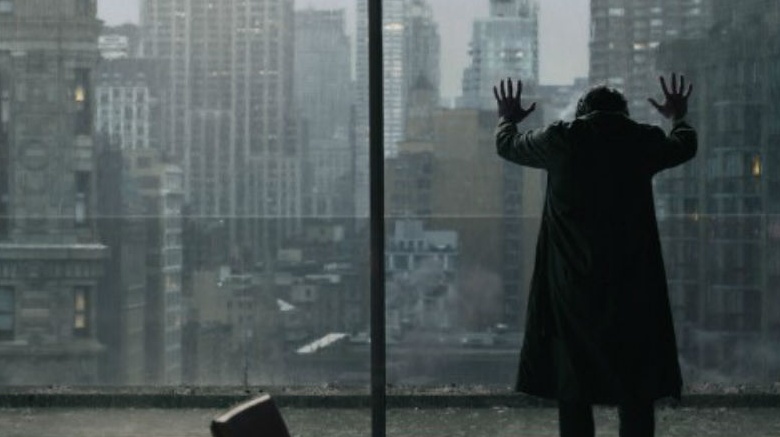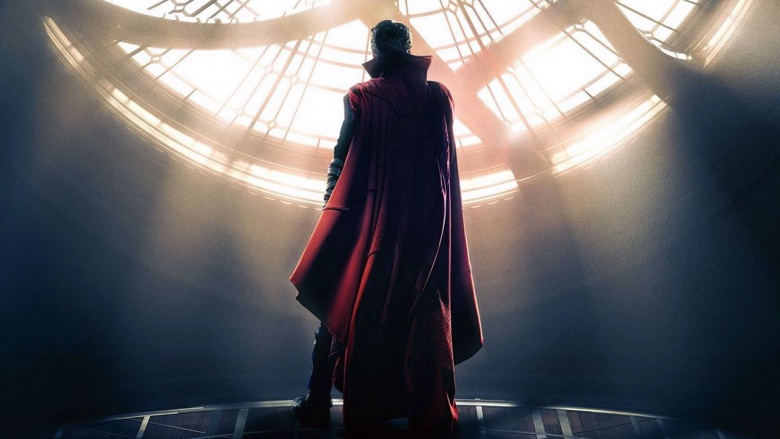Biggest Unanswered Questions In Doctor Strange
Doctor Strange is master class in visual effects and taps into whole new dimension—several of them, actually—for the Marvel Cinematic Universe to explore. Phase Three is truly in gear, folks. But with so many elements in play, from time manipulation to the multiverse to metaphysics, spiritual energies, and even magic flying cloaks, there was so much to explain that there were bound to be a few loose ends left straggling. Here are some of the major questions Doctor Strange left unanswered.
Why was Earth so important to Dormammu?
As with many of Marvel's movie properties, our mega-villain of the day is a creature that defies all ordinary understanding of the world—but has a particular interest in our little old planet. Dormammu exists as a time- and space-free being that likes to feed on the "generous" parts of the universe that give life, and he (or should we say it?) has set a giant purple eye on Earth for some inexplicable reason.
At least that's according to Wong, the librarian of Kamar-Taj (a job that is not without its dangers, as the opening scene so gruesomely revealed), and his colleague Mordo. And Dormammu proves as much when he uses Kaecilius as his gateway to get past the Ancient One and her band of sorcerers and try to take over the planet. What's not clear, however, is why Earth is of such value to this creature. Sure, we're one of those planets that sustains life, but as the Ancient One so exquisitely displayed, the multi-verse is enormous. Why is Earth such an important conquest for Dormammu? It wouldn't be a movie if not, that's why. Shrug.
How old was the Ancient One?
Early on, Doctor Strange begs the question we're all asking—exactly how ancient is the Ancient One?—but it's never answered in the film. We're instead given, through the mouth of Mordo, some vague minor details about how she's of Celtic descent but nobody knows anything more than that.
We're left to only imagine how she lost her hair, where those scars on her head came from, and how she came into such power and sophisticated understanding of magic. We don't get to know her real name or why, if she has such unlimited access to the entire continuum of existence, she remains here on Earth of literally all places.
If Mordo was so stiff inside, why was he the Ancient One's top minion?
We're told that Mordo once came to the Ancient One with an injury of his own, but exactly what that is we still don't know. His facial scars don't precisely betray that information. More importantly, it isn't clear why he was ever chosen to be her apparent second in command. She certainly doesn't inspire confidence when she tells Doctor Strange that she thinks Mordo has an inflexible soul and can only conjure up "he's strong" as a compliment for the character.
What was the real nature of Strange's relationship with Dr. Palmer?
It's clear that Doctor Strange and Doctor Palmer have a history together, but we don't know anything close to the whole story. On the one hand (pardon the pun), he's all too quick to lash out at her with a cruel cut about how they were barely even lovers; on the other, he clings to a watch she gave him. The timepiece has an inscription about how their love will be tested by time, but the way they work together in the beginning makes it seem like their relationship was just a fling that became the butt of a joke about her new no-dating policy at work. Obviously he was just trying to push her away with his cruel words, but why did they break up in the first place? It's an irritatingly underdeveloped part of the narrative.
Why didn't Strange save the Ancient One?
There are any number of reasons it doesn't make sense for the Ancient One to die when she does. For starters, she gave that big speech about how the body has the ability to heal itself with the right spiritual motivation—and indicated that she's fluent in whatever metaphysical language that would require. No matter how grave her wounds might have been during the battle with Kaecilius, she should've been able to help herself. And if she was, as her absurd astral monologue indicated, just giving up on herself, couldn't she have at least waited until they finished the fight with Kaecilius and Dormammu? Leaving Earth in the exact sort of peril she'd worked so long to stave off seems like completely senseless timing.
Speaking of time, Doctor Strange definitely had the ability to manipulate it by the point of her ultimate injury, so why didn't he whip out his event reversal trick to save her ... or the London Sanctum ... or undo everything in New York, for that matter? The question of why time-manipulation devices only get used sometimes is not exclusive to Doctor Strange, of course—Hermione could've done a lot more with her Harry Potter time-turner if she wanted to, to give but one example. But still. Doctor Strange could've given it a shot, at least.
Why was Strange allowed to just keep the Eye of Agamotto?
After Doctor Strange is caught in the library messing with a forbidden ritual in one of the Ancient One's books after lifting the Eye of Agamotto from its stand, he just kind of runs with it for a while. Sure, there was some distraction involved, once he revealed that he knew what it could do and what the missing pages from her book included. But Wong was so precious about other items in his charge that you'd think he'd not-so-kindly instruct Strange to put the mystical device back in place at some point or another.
Did Pangborn use his sorcery for more than just his body?
In the post-credits scene, Mordo, who's broken bad after learning that the Ancient One had been lying to him and drawing on dark energy, claims his first victim: Jonathan Pangborn. He finds Pangborn, who chose not to be a part of the Ancient One's army and instead used his gift for self-preservation, and strips him of his power because, in Mordo's words, the real problem right now is that Earth has too many sorcerers.
But why Pangborn? The guy was in exactly one prior scene, playing a street basketball game and otherwise quietly going about his life. Either Mordo was getting vengeance for Pangborn being the one to tip Strange off to Kamar-Taj, or Pangborn was doing more than just shooting hoops in his downtime. But none of that gets fleshed out in the limited time he's brought back to suffer Mordo's wrath.
Why didn't Strange heal his hands?
When Strange first joins the crew at Kamar-Taj, he's not strong enough to heal himself, that we know. What we don't know is why, after he ascends to untold strength and capability, he's not able (or perhaps not willing?) to undo the nerve damage to his hands. He complains about it enough, so it's not as though he's completely lost interest in the idea of healing himself, but it just never happens. Is it because of the one-handed master who showed off his fire-spinning skills? Did that change his mind? Or is he still just incapable of willing his cells and nerves to correct themselves? Hard to say.
Why didn't the Ancient One get purple eyes too?
Kaecilius and his cohorts all got some purple skin masks, complete with scaly Stone Man rot around their eyes, once they started channeling dark power. However, they only shared one facial tell with the Ancient One, who'd done the same: The insignia on their foreheads. Why is it that she was immune to the Dormammu mask, but not the symbol, when she was channeling dark power? One theory might be that it's because she wasn't like them, exactly—even though she was using that power for her own benefit, she hadn't accepted Dormammu into her heart ... or something. Who knows.
Were there any rules to sorcerers talking about Kamar-Taj?
Another oddity in Doctor Strange was how loose-lipped these sorcerer protégés seemed to be about Kamar-Taj. Pangborn knew Strange for all of two minutes before he let the source of his healing slip. Meanwhile, Mordo was quick to guide him there, no questions asked, when he heard him mutter the name in passing. It's all a matter of moving the plot along in both cases, of course, but are there any rules to when, how, and/or why you can just divulge this information to strangers? Seems like they might be a little more guarded about their precious sanctuary is all we're sayin'.
Did Strange change the properties of Dormammu when he introduced time to it?
In the big climax of the movie, Doctor Strange figures out that he's got one over on the supposedly all-powerful Dormammu. He creates a time loop in a place where time isn't even supposed to exist and traps Dormammu in an effort to strike a bargain. Dormammu responds by killing Strange in every way the thing knows how, again and again, before finally begging to be set free. Dormammu agrees to steer clear of Earth forever—guess it wasn't his prized possession-to-be after all—in exchange for Doctor Strange cutting off the time loop.
Here's a question, though. When Doctor Strange introduced time to Dormammu's otherwise timeless dimension, did he change it in any way? Does this alteration hold a bigger significance for Dormammu's dark plane? In the comics, these two have tangled repeatedly, and it's worth wondering whether this showdown holds the key to how and when we might see this villain in the MCU again.
What happened to Kaecilius and his pals?
When Doctor Strange banishes Kaecilius and his lackeys to Dormammu's dimension, they float up and are instantly flayed alive—or so it seems. He says they're still getting their wish for eternal life, but it isn't going to be pleasant. What Strange experienced during his limited time in Dormammu's dimension was an endless barrage of brutality. Are we to assume that's what's coming their way, too? They're obviously in the doghouse after picking the fight that led Doctor Strange to Dormammu's door, but Kaecilius was clearly a powerful sorcerer. It isn't hard to imagine Dormammu keeping him around for the next battle—and given that Mads Mikkelsen was so much fun to watch as Kaecilius, that's a plan we'd wholeheartedly support.
Who wore the Cloak of Levitation before Dr. Strange?
The Ancient One hints that the Cloak of Levitation is a fickle creature, but that's all we know about it. It's a compliment to Strange that the Cloak has chosen him, but why? What became of its last owner? Did the Ancient One know this person? Is it, as it seems, a sentient being? The other magical artifacts we saw didn't seem to have such strong personalities, so what makes the Cloak so different?
Why do the astral projections only move some objects?
When Strange is being patched up (and zapped back to Earthly life) by Palmer in the hospital, one of Kaecilius' henchmen hops through his sling ring portal in astral form and starts a knock-down, drag-out battle with Strange's astral form. All of this is out of Palmer's view, but every once in awhile their spiritual smackdown causes some real-life ruckus in the operating room. How and why some of these astral motions affect the physical plane, while others don't, is an intriguing question—but with all of these questions, to paraphrase the Ancient One, sometimes things don't have to make sense. Either way, Doctor Strange was one heck of a fun ride, and we can't wait to see Benedict Cumberbatch back in action.














